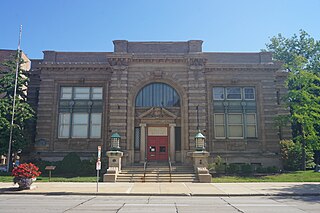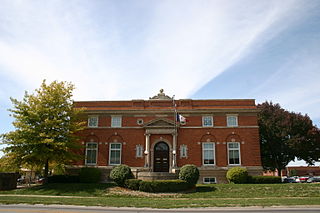
Janesville is a city in and the county seat of Rock County, Wisconsin, United States. As of the 2020 census, the city had a population of 65,615, making it the tenth-most populous city in Wisconsin. It is a principal municipality of the Janesville–Beloit metropolitan statistical area, which consists of all of Rock County and is included in the greater Madison–Janesville–Beloit combined statistical area.

The Aitkin Carnegie Library is a Carnegie library in Aitkin, Minnesota, United States. It was designed by architects Claude & Starck and was built in the Classical Revival style. It was listed on the National Register of Historic Places in 1982.

The Jennings Carnegie Public Library is a Carnegie library located at 303 North Cary Avenue in Jennings, Louisiana.

The Adrian Public Library is a historic structure located at 110 East Church Street in downtown Adrian, Michigan. Originally used as a library, it was designated as a Michigan Historic Site on December 14, 1976, and later listed on the National Register of Historic Places on December 6, 1977. It is located within the Downtown Adrian Commercial Historic District and adjacent to the Adrian Engine House No. 1. Today, the building houses the Lenawee County Historical Society Museum.

The Smith County Historical Society, housed in the Carnegie Library, is located at 125 S. College Street in the city of Tyler, Smith County, Texas, U.S. It was built in 1904 as the Carnegie Public Library, and added to the National Register of Historic Places listings in Smith County, Texas in 1979. When Tyler built a new public library, the Carnegie building was leased to the Smith County Historical Society and continues to operate as a museum and archives.

The Carnegie Library is a historic building still in use as the Hoquiam Timberland Library in Hoquiam, Washington.

The Bemidji Carnegie Library is a former library building in Bemidji, Minnesota, United States. It was built as a Carnegie library in 1909 and housed the city's public library until 1961. It was listed on the National Register of Historic Places in 1980 for its local significance in the themes of architecture and education. It was nominated for being a well-preserved example of a Carnegie library and of public Neoclassical architecture.

Dwight T. Parker Public Library is a public library in Fennimore, Wisconsin. The building was constructed in 1923 to house the city's library, which had previously been based in a Methodist church and the Old Fennimore House. Dwight T. Parker, a local banker, funded the library. The architectural firm Claude & Starck designed the structure in a mixture of the Mediterranean Revival and neoclassical styles; the brick building features terra cotta ornamentation and a tile roof.

The Fletcher Free Library is the public library serving Burlington, Vermont. It is located at 235 College Street, in an architecturally distinguished Beaux-Arts building, constructed in 1902 with funding support from Andrew Carnegie. The building was listed on the National Register of Historic Places in 1976.

The Racine Heritage Museum is a historical museum building and former Carnegie library, located at 701 S. Main St. in downtown Racine, Wisconsin. Designed by John Mauran in the Beaux-Arts style, the building served as the Racine Public Library from 1904 until 1958, and has housed the Racine Heritage Museum since 1963. It is also the home of the Racine County Historical Society. It was added to the National Register of Historic Places on March 20, 1981.

Drake Public Library is a public library located in Centerville, Iowa, United States. It was established in 1901, and the building was placed on the National Register of Historic Places in 1997.

Oskaloosa Public Library is a facility located in Oskaloosa, Iowa, United States. Construction of the library was launched in 1902 with a grant from the Carnegie Corporation of New York. The building was added to the National Register of Historic Places in 1991.

Chariton Public Library is located in Chariton, Iowa, United States. The Library and Reading Room Association was formed in Chariton in 1879, but it was short-lived. The county superintendent of schools started a teachers' library in the courthouse sometime afterward. By this time the community had a library of 800 volumes. There was an effort by study clubs in town in 1898 to raise money and establish a free public library. The Chariton Federation of Women's Clubs took the lead and opened a library with the books from the courthouse in two rooms above Gibbons Drug Store on the town square. Citizens approved a local tax to support the library the following year.

The Mason City Public Library is located in Mason City, Iowa, United States. The building that was funded by Andrew Carnegie, and is now an office building, was listed on the National Register of Historic Places in 1989. It was included as a contributing property in the Mason City Downtown Historic District in 2005.

The Marion Carnegie Public Library is a historic building located in Marion, Iowa, United States. The Marion Federation of Women's Clubs was established in 1901 with the purpose of organizing a public library. Adeliza Daniels was the primary force behind the organization, and she contacted Andrew Carnegie to donate funds for the building. After he agreed to a grant of $11,500, the Cedar Rapids architectural firm of Dieman and Fiske designed the brick Neoclassical building. Cedar Rapids contractor A.H. Conner was responsible for construction. It is a single-story structure built over a raised basement and a proment pedimented main entrance. The new library was dedicated on March 16, 1905, and served the community in that form until 1957. In that year the auditorium in the basement was remodeled into a children's reading room. A three-story addition, which doubled the size of the building, was completed in 1961. The building was individually listed on the National Register of Historic Places in 1994. The Marion Public Library has subsequently moved to a new facility, and the Carnegie building is now part of the First United Methodist Church complex. In 2009 it was included as a contributing property in the Marion Commercial Historic District.

The Janesville Free Public Library is the public library in Janesville, Minnesota, United States. It is housed in a Carnegie library building constructed in 1912. It is part of the Waseca-Le Sueur Regional Library System, which is a participant in the Traverse des Sioux Library System. The Janesville library building was listed on the National Register of Historic Places in 1982 for its local significance in the themes of architecture and educaction. It was nominated for being a well-preserved example of the 65 libraries founded in Minnesota by Andrew Carnegie's philanthropy, and for its Neoclassical architecture.

The South Main Street Historic District a fairly intact remnant of Janesville, Wisconsin's old downtown east of the Rock River, built in the 19th and early 20th centuries. In 1990 the district was added to the National Register of Historic Places.

The Carnegie Public Library is a Neoclassical building designed by Tourtellotte & Co. and constructed in Boise, Idaho, in 1904–1905. It was individually listed on the National Register of Historic Places in 1974. In 1982 it was included as a contributing property in the Fort Street Historic District.

The Little Falls Carnegie Library is a historic Carnegie library in Little Falls, Minnesota. It was added to the National Register of Historic Places on November 3, 1980, for its architectural significance.

The Baraboo Public Library, also known as the Carnegie-Schadde Memorial Public Library, is the public library serving Baraboo, Wisconsin. Located at 230 4th Avenue, the Carnegie library was built in 1903. It was one of the first small-scale Carnegie libraries in Wisconsin. Architects Claude and Starck of Madison designed the Neoclassical building; the firm designed 39 libraries in the early twentieth century, many of which were funded by Carnegie, and the Baraboo library was one of their first works. The library's design features a projecting entrance portico flanked by Ionic columns and topped with a pediment and a dentillated entablature along the bottom of the tiled hip roof.




















